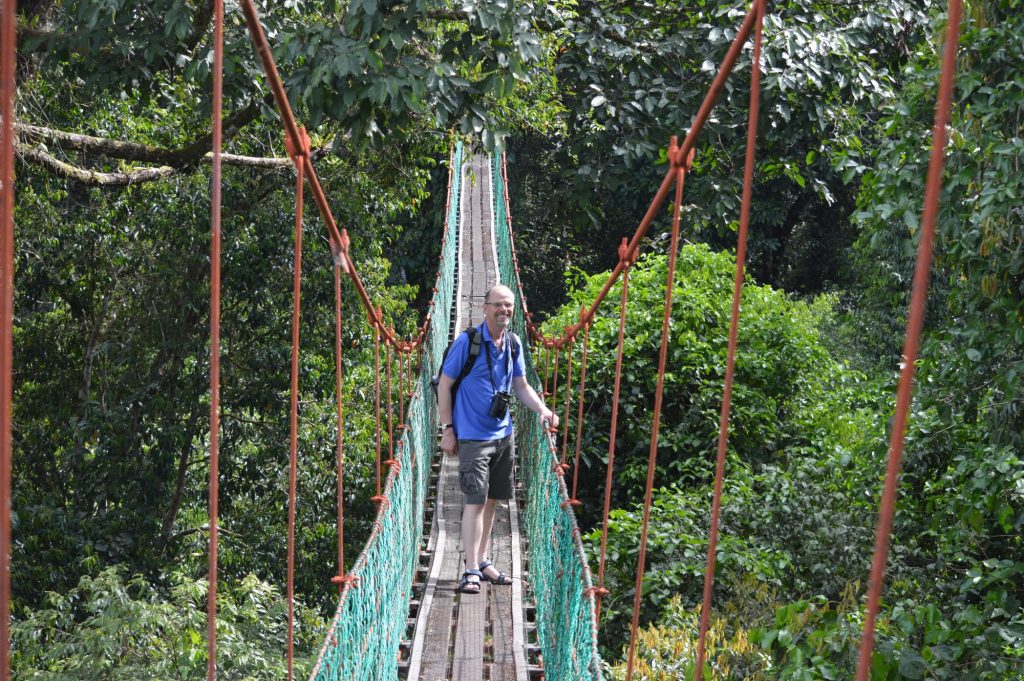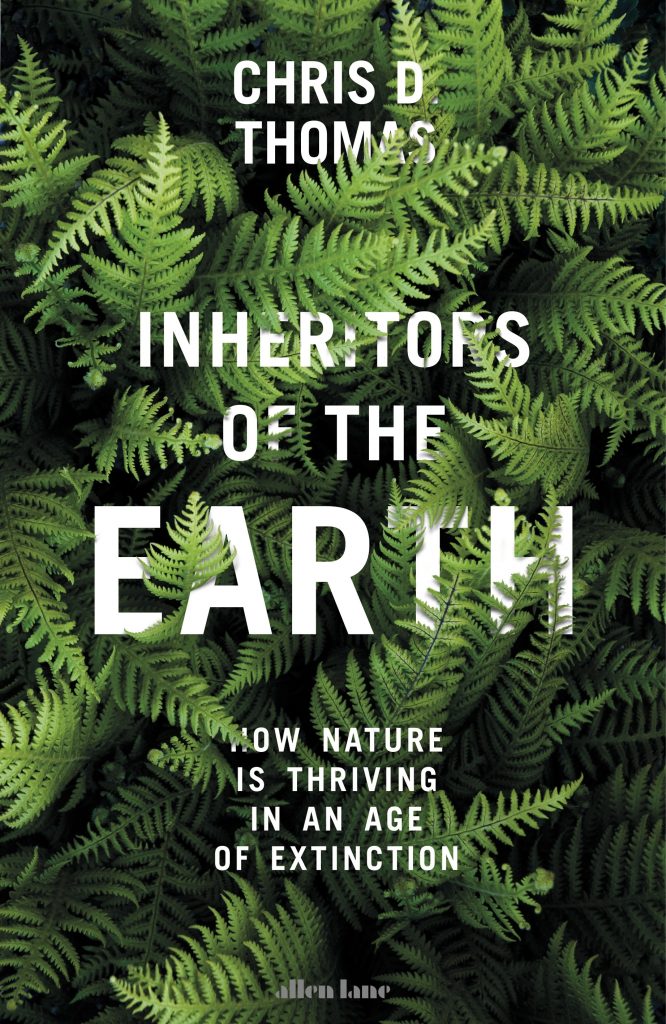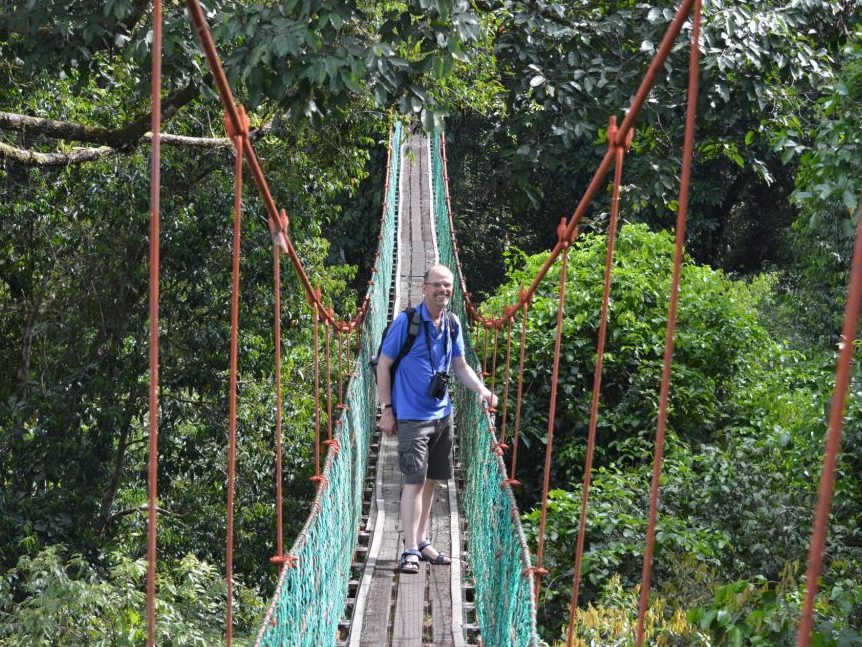
Chris D. Thomas is a Professor in the Department of Biology at the University of York and was elected as a Fellow of the Royal Society in July 2012. He has an interest in understanding how humans have changed the biological world, and how we might protect the biodiversity that remains. His first book, Inheritors of the Earth, is a very interesting and thought-provoking read on the current mass extinction crisis, and conservation philosophy in general, focusing on the proverbial winners, and calling out conservationists for holding viewpoints that seem more driven by nostalgia than by logical thinking about the biological future of our planet. Sure to ruffle some feathers, NHBS nevertheless believes that this book makes an important contribution, and that his arguments are more balanced than a cursory glance might suggest. We contacted Chris with a list of questions that arose after reading it.
1. In your book, you quite rightly argue that, despite species going extinct, there are species who are benefitting from our presence and the changes we have wrought to our ecosystems. You acknowledge that our influences largely seem to result in an accelerated introduction of species in new areas. Will the net result of this great reshuffling not be a world that is suited only to generalist species (the proverbial rats and pigeons) at the expense of specialists?
This is not quite how I see it. Take your two examples. The Asian brown rat was a regular rodent (granted it was omnivorous, but so are many other rodents), before it hitched a lift with us around the world. Today, the brown rat mainly lives in and around human habitation and farmland, except on islands that lack native rodents, so you could simply call it a specialist on human-modified environments. The feral or town pigeon originated as a specialist cliff-nesting pigeon (the rock dove) in western Europe, the Mediterranean, and into western Asia. It is still a cliff-nesting bird, living on our buildings. Neither the feral pigeon nor the brown rats are unusually generalised, relative to many other birds and mammals. It is their proximity to us that makes us think of them as generalists. I don’t think we should synonymise ‘successful’ or ‘living in human-modified environments’ with being a ‘generalist’.
2. In Chapter 6, “Heirs to the World”, you mention that most current conservation efforts focus on trying to defend the losers. You argue that, though honourable, it will be more effective to back the winners, i.e. those species that will make up future biological communities. An important theme in the recent book Never Out of Season: How Having the Food We Want When We Want it Threatens Our Food Supply and Our Future is that the loss of wild crop varieties through extinction is threatening our future food supply. Many of these wild varieties might have the potential of providing new food sources when our current crop varieties will inevitably succumb to new insect pests or pathogens, or can provide other benefits (e.g. pharmaceuticals). This is why projects such as the Svalbard Global Seed Vault and other seed banks are so important. Do you see any value in the conservation of threatened species, or is this crying over spilt milk?
I argue that we should in most instances continue to protect ‘species’. Rare species may become common and hence fulfil important roles in future ecosystems, and species that we currently ignore (or have not yet discovered) may become economically, medically or socially important to us in the future. Hanging onto as many species as possible is not a preservationist agenda, but rather a means of maintaining the building blocks of future ecosystems, fuelling biological changes that will take place in the coming centuries. Similar arguments apply to rare genes that belong to wild relatives of plants and livestock that we already use. They provide long-term resilience and flexibility.
3. In Chapter 11, “Noah’s Earth”, you call for a new conservation philosophy that acknowledges that life is a process, not a final product. In your view, this philosophy would rest on four overarching principles: a) accept change, b) maintain flexibility for future change by conserving species wherever possible, c) accept that humans are natural and that anything we do is part of the evolutionary history of life (this includes not shying back from employing any and all solutions at our disposal, including genetic techniques – none of them will make the world less natural), d) live within our natural boundaries. In the remainder of that chapter you elaborate on the first three principles, but not the fourth. How do you envision realising this fourth principle?
As I say: “We know that we cannot expect the bounty to continue if we carry on killing animals faster than they can breed or cut forests down faster than they grow. This strategy failed when our ancestors drove most of the world’s largest land animals to extinction, and it has played out in the last few centuries as whale and fish populations have collapsed under the pressure of over-harvesting. We need a resilient and sustainable approach. We should aim for maximum efficiency, by which I mean that we should pursue strategies that fulfil all human needs – and, where possible, desires – of every citizen on Earth while generating the least possible collateral damage to the global environment.”
Harvesting a species faster than the survivors can reproduce can be thought of as a relatively ‘hard’ natural boundary (once a species is extinct, it is no longer a resource), but other bounds are much softer (a forest with one fewer species still grows), and hence we often need to specify tolerable levels of change, rather than catastrophic points of no return. These issues deserve book-length treatment on their own, which is why I did (deliberately) somewhat duck the issues!
When I refer to the ‘least possible collateral damage to the global environment’, I am thinking about the development of technological and social ‘game changers’. For example, most meat production is based on filling our fields and barns with cows, sheep and chickens, which we then kill for food. If we could switch to the consumption of ‘factory-grown’ cultured meats, powered by renewable energy, it would dramatically reduce pressure on the land; although admittedly not by as much as if we all became vegetarians.
4. Your book makes many valid points as to how our current thinking around species conservation is in conflict with itself, or simply illogical (e.g. the distinction between native and invasive species, because, seen over long enough time scales, species distribution has always fluctuated. Or the idea that there is no one period in the history of life that we can take as a benchmark of the idealised pristine state the world should be in. Or simply the idea that conservation means “freezing” the world in its current (or a former) state – after all, the only constant of life on our planet has always been change). You also, provocatively I would say, argue that many island species that have gone extinct were effectively already evolutionary dead ends, having evolved in environments free from predators and pathogens. We have merely hastened their demise, but they would eventually have gone extinct anyway. Should we really give up on them?
I don’t think it is particularly controversial (or provocative, therefore) to say that most flightless and disease-susceptible terrestrial birds (as opposed to seabirds) that live on oceanic islands represent evolutionary dead-ends, on a time scale of ten or so million years. What are the alternatives? They would never be able to establish viable populations on continents because pathogens and predators are present. Confined to their island homes, they would eventually have died out, either when the islands eroded away, or when additional continental species arrived without human intervention (for example Darwin’s finches have ‘only’ been on the Galapagos for two to three million years). In most cases, we have accelerated the extinction of such species but not altered their eventual fate.
What we should do with the few remaining survivors is another issue. What I argue in Inheritors of the Earth is that we should think quite broadly. Can we introduce new genes to disease-susceptible birds that will make them resistant (for example to save the remaining Hawaiian honeycreepers)? Can we cross predator-susceptible birds with related species that reproduce fast enough to survive the new levels of predation (for example to save New Zealand black stilts)? Could we introduce new strains of bird malaria that are less potent, and displace the existing fatal ones? In other words, can we make the endangered island forms more resistant in some way and the continental invaders less virulent, so that long-term coexistence becomes possible? If not, then maybe we should indeed abandon some of the losers, and contemplate releasing continental walking birds (which can resist pathogens and predators) and pollinators, rather than dwell too long attempting to recreate a biological world that was inherently unstable.
 5. One argument in favour of trying to conserve the “charismatic megafauna”, such as elephants and rhinos, are that they function as flagship species, and that conservation efforts aimed at them can benefit whole ecosystems. In your book, you don’t really go into this. What are your thoughts on the concept of flagship species, especially in light of your argument that “defending the losers” is ultimately a lost cause?
5. One argument in favour of trying to conserve the “charismatic megafauna”, such as elephants and rhinos, are that they function as flagship species, and that conservation efforts aimed at them can benefit whole ecosystems. In your book, you don’t really go into this. What are your thoughts on the concept of flagship species, especially in light of your argument that “defending the losers” is ultimately a lost cause?
I am generally in favour of large, flagship species because they require large areas to protect, and this indirectly benefits many other species (though flagship conservation is not sufficient because it may miss areas of endemism). They are also culturally important to conservationists as well as to the general public, gaining public and political support for conservation. The giant panda has been globally important, and critical to the conservation of Chinese forests, despite being a slightly ‘dodgy species’!
When I discuss losers, remember that I then add the question “can we turn them into winners” (or at least into survivors). For the large megafauna that still survive, this is easy. We can choose not to hunt them to extinction any longer. It is already the case that large birds and large mammals are tending to recover in Europe and North America, and this is also true of the Great Whales. They were losers in the context of historic human culture, and there is no necessary reason why they ‘must be’ losers. Once ivory and rhino horn ‘culture’ is turned around, there will be nothing ‘wrong’ with these species either.
6. If you were put in charge of a major conservation organisation, say WWF, what would you do differently? Would you, for example, have greenlighted their recent campaign to try and protect the last remaining individual vaquitas (the threatened porpoise endemic to the Gulf of California)?
I’m not going to answer your first question because that would be a whole new book (or job if they offer it to me!). I’ll just say that, on day one, I would request a review of activities, and for every measure currently being undertaken to prevent change or decline, I would ask for the staff to develop an additional measures to promote changes that would increase diversity (or the status of an endangered species).
As for the vaquita, I am no expert. However, it is evolutionary distinct, and it is a perfectly viable species if we were stop killing it (including through gillnets). It is not a species that one should necessarily give up on. More broadly, it is a symptom of the mismanagement of the world’s marine resources. We sorted out farming on land a long time ago, but we are still more or less acting as hunter-gatherers in the marine realm. It is hopelessly inefficient.
If I had an infinite supply of money, I would be looking to invest in fish farms (they can be locally damaging, but humans still need food), and I would also invest in new GM crops which produce fish oils so that the farmed fish could be fed on terrestrial plants rather than ‘wild caught’ marine resources. Beyond that, I would invest in cultured fish meat (factory grown muscles), further reducing the need to catch wild fish. The aim would be for virtually all fish consumed in the year 2100 to be farmed or, ideally, cultured as tissues in factories.
Whether or not the vaquita itself can be saved, these strategies are all about generating permanent means of providing a global supply of fish meat without causing anything like as much collateral damage as takes place at present.
7. As mentioned above, I think your book makes excellent arguments. And yet, reading it also brought with it a certain sense of unease. It almost feels a bit defeatist, as if we might just as well give up on fighting to save threatened species and just go with the flow. I can see this argument not being popular. A lot of people feel we have a moral responsibility, as an intelligent, thinking species, to not drive other species over the edge, and to put a stop to our destructive ways. Isn’t saying “everything we do is natural, we are just another step in the evolution of life” a bit of a cop out?
I’ll leave others to discuss morals!
Saying that everything is natural, including all conservation actions we take, allows us to take ‘affirmative action’ for wildlife in a manner that some conservationists would historically have been nervous about (“I can’t do that, it would not be natural”). So, I see it as an opening up of new conservation opportunities, not a cop out.
8. It is perhaps a bit early to ask you how the book has been received. But, clearly, when a book like this is written, it is often based on years of work and research that has led up to it. These ideas did not just appear. So, how have your viewpoints been received so far?
The response to the book seems good so far, but it is far too early to judge. You are right, I have put some of these views out there previously, and they have received a mixture of responses. Many people seem very supportive. However, invasive species biologists are mostly negative, I think fearing that non-native species legislation could be undermined, more than genuinely questioning the biological thesis (that may just be my interpretation). There are also those, such as E. O. Wilson, who consider that I and others are being Anthropocene apologists. I understand their point, but we cannot simply continue to wish that we live in an unchanged world. We have to develop an understanding of biology, and an approach to conservation, that works with change rather than against it.
9. Obviously, there are many parties in our society who stand to gain a great deal from ignoring conservation concerns and steam-rolling ahead with “business as usual”, continuing to destroy natural habitats for corporate gains. With this book now poised to be published, do you not worry that your narrative will be hijacked, the way has happened with the debate surrounding climate change? I can already see people using your arguments to legitimise their actions, arguing along the lines of “this biologist said that the extinction crisis really isn’t such a big deal. See? Lots of species doing really well!”. Have you considered strategies to prevent this from happening?
I nearly didn’t put fingers to keyboard for this very reason. However, if we build a case for conservation based on a loss-only view of the world, eventually it will fall. The edifice is already creaking. A more balanced view that admits to the reality of biological gains as well as losses should, in the end, lead to more rational decision-making.
In terms of conservation, I have stated my own views. In the Epilogue, I write: “If [existing conservation] efforts were abandoned, the extinction rate would escalate. A major task of conservation is to keep the losses towards the lower end of the likely range – as well as to encourage biological gains. Although I have been advocating a more flexible approach to the environment, and specifically to conservation, nothing I have said should be used to undermine attempts to save existing species or maintain protected areas.”
As for the extinction ‘big deal’, biological gains of the Anthropocene do not let us off the hook. A simple linear extrapolation of the current rate of extinction wipes out about three-quarters of all species in the next ten millennia. This is risky, given that species represent our planet’s biological parachute. All future ecosystems will be formed from the descendants of existing species, and we do not know which of today’s currently-rare species will be important components of future ecosystems (especially if humans alter the planet in yet another, unexpected way). Letting rare species go could have major long-term consequences. My advice would be not to discard the biological building blocks of our planet lightly.
Inheritors of the Earth is available to order from NHBS

